Film Explores Delaware Tribe’s History in Indiana
By: Roseanne McKee
On April 12, 2014, Ball State University in Muncie, Indiana, held a special showing of a new documentary about the Delaware Tribe of Indians, for the period in which they made Indiana their home.
The award-winning documentary, prepared by Communications Department students, through filmed re-enactments and interviews, chronicles the forced migration of the Delaware Tribe from their original home in the region now known as southern New York, New Jersey and Delaware through: Pennsylvania, Ohio, Indiana, Missouri, Kansas and present-day Oklahoma.
This 30-minute documentary, entitled Lenape on the Wapahani, explores the historical record of the Delaware Tribe establishing a village near Muncie, Indiana, where Ball State University is located, and the reasons for the Delaware Tribe’s arrival and departure from Indiana.
The group that made the trip to Indiana for the April 12 showing were: Chief of the Delaware Tribe, Paula Pechonick, Tribal Archivist, Anita Davis Mathis and Tribal Manager, Curtis Zunigha. They travelled to Ball State University for the showing and to visit previous village sites along the Wapahani, or White River, in Indiana. Wapahani is the Delaware’s name for the White River. A group of ten Delaware living in Indiana also responded to the invitation for the showing, Mathis said.
“The documentary reconstructs our Indiana history. In 1795 the Greenville Treaty took our ancestors to Indiana and the St. Mary’s Treaty took us out in 1818,” Mathis said.
“The Delaware set up a series of villages starting just below present day Muncie to about the Marion County line above Indianapolis,” Conner Prairie Interactive History Park Historian Tim Crumrin said in the documentary. “There were as many as 12 to 14 villages. There were permanent and seasonal ones,” Crumrin said. “Six stood the test of time. The others were either trading post villages or temporary villages they would set up.”
Mathis said that during the visit to Indiana in April, “they took us to a park where our own village was – where two rivers meet – the White and the Buck River, Tribal Archivist, Anita Mathis, said in an interview May 5. One thing that struck her was that “where the rivers met, there were two different colors,” Mathis said.
During the visit, Zunigha offered a prayer, Mathis said. “He took from his cedar chest and offered tobacco at the site. This is a gift to the land and the spirits. He threw it on the ground facing the east and prayed and then offered some to the water. His prayers were said in English and in Delaware.”
Mathis said she was grateful that Ball State University had provided her with raw interview footage and information to add to the Delaware Tribe’s archives with details about this period. “In 1751 the Delaware moved to Eastern Ohio and in 1795 they moved to Indiana,” Mathis said.
Mathis said that she had learned that her ancestors had “lived very simply. It wasn’t uncommon at all for the eldest to be raised by the grandparents. Normally the first born would be raised by the grandparents and then in turn take care of the grandparents.”
In the documentary Crumrin called the Delaware “possibly the most oft moved group in American history.”
The Europeans first encountered the Delaware in the 1560’s according to Historian Mike Pace, who is Delaware, of the Conner Prairie Interactive History Park. A clash of cultures resulted. “The Europeans believed in amassing wealth and in ownership of land,” Pace explained.
“The tribes here believed not in the ownership of land. The land was for everybody to share in. We did not have a reason to amass wealth…” Pace said. Nonetheless, over time the Delaware were again moved and agreed to accept land in Kansas territory.
“We were the first tribe to sign a treaty with the new U.S. government in 1778,” Mathis said.
“The Delaware moving from their original homeland back East, those moves were precipitated by agreements with European countries or the new United States of America through treaties,” Curtis Zunigha said in the documentary.
After leaving Indiana, the Delaware stopped in Missouri, before settling in Kansas for a time, Mathis said.
“When they left Indiana they came to Missouri, by Springfield for a couple of years and then went into Kansas where they had over two million acres – Kansas City, Leavenworth, Lawrence, Kansas. By 1835 they were all in Kansas, where they stayed until 1867,” Mathis said.
“We got paid in Kansas for our lands and paid the Cherokee for what is now Washington County, [Oklahoma],” she added.
According to the text of the document provided by Mathis, on April 8, 1867, the Delaware signed a Memorandum of Agreement with the Cherokee to pay $1.00 per acre for 160 acres for each man, woman, and child of the Delaware Tribe “for the use of the lands by which to preserve their tribal organization and laws for a total sum of $157,600. In addition, the Delaware paid the sum of $121,824.28 to the Cherokee as a proportional amount of the Cherokee National fund determined by the number of Delawares as compared to the whole number of Cherokee.”
The Cherokee Nation viewed this payment for lands as a lease rather than a land purchase, Mathis explained. Unable to persuade the Bureau of Indian Affairs otherwise, the Delaware Tribe had no reservation as a result.
“We’re a landless tribe except for the land we now have — seven acres in Caney and then the 93 acres in Lawrence, [Kansas]. Some of which is on the original reservation,” Mathis said.
The documentary described the Delaware Tribe as “a persistent people.” With a long history of forced migration, the Delaware, nonetheless, retained their tribal identity.
“Many other tribes did not survive or they’ve had to be absorbed by other tribes to survive. That persistence is because we have an obligation to keep our identity, our language, our culture and tribal identity because it is a gift from the Creator,” Zunigha said in the documentary.
“Wherever they moved, they began to have a relationship with the river, the water that gave them life and sustenance,” Zunigha explained.
In the documentary the Delaware are referred to as Lenape. The Delaware name began being used to describe the Lenape because of their location near the Delaware River, which was named after Lord Dela Warr, Crumrin explained.
“The original land of the Lenape, that ties to all of our creation legends, the first memory of who we are as a people originated in that river valley and all the way to the Atlantic Ocean. Our creation legend says that a great turtle rose from the ocean to create Turtle Island – the North American continent,” Zunigha said.
Mathis is pleased a portion of the Kansas acreage purchased is on land that was part of the Delaware Tribe’s Kansas reservation. The land will provide a base operation in Kansas to provide services to members of the Delaware Tribe and to advance the preservation of their language, culture and lifeways.
Perhaps most important, the purchase of the 93 acres in Kansas by the Delaware Tribe provides a fresh opportunity for something that the Delaware have not had since they left their original home – a place to call their own.
The documentary may be viewed at www.lenapeonthewapahani.org.
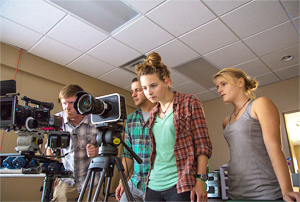 Gaffer Andrew Bultemeier, Cinematographer R. Aaron Webster, Director Kayla Eiler, and 1st Asst Camera Kathie Green prepare for interviews on Bartlesville campus. Gaffer Andrew Bultemeier, Cinematographer R. Aaron Webster, Director Kayla Eiler, and 1st Asst Camera Kathie Green prepare for interviews on Bartlesville campus. |
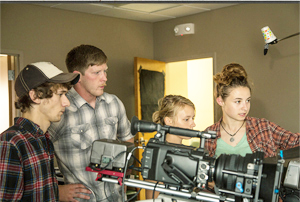 Field Audio Specialist Ben Kruis, Gaffer Andrew Bultemeier, 1st Asst Camera Kathie Green, and Director Kayla Eiler. Field Audio Specialist Ben Kruis, Gaffer Andrew Bultemeier, 1st Asst Camera Kathie Green, and Director Kayla Eiler. |
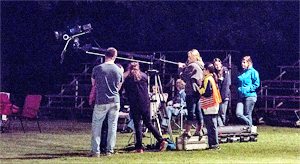 Crew films during Delaware Days, September 2013. Crew films during Delaware Days, September 2013. |
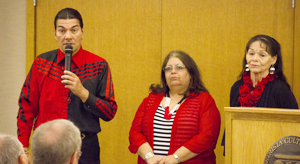 Curtis Zunigha, Director of Cultural Resources Anita Mathis, and Chief Paula Pechonick answer questions at premiere showing at Ball State University, April 2014. Curtis Zunigha, Director of Cultural Resources Anita Mathis, and Chief Paula Pechonick answer questions at premiere showing at Ball State University, April 2014. |
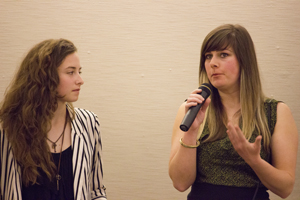 Executive Director Alina Beteringhe answers questions with Kayla Eiler. Executive Director Alina Beteringhe answers questions with Kayla Eiler. |
 Executive Producer Kelli Huth talks with Tribal Manager Curtis Zunigha. Executive Producer Kelli Huth talks with Tribal Manager Curtis Zunigha. |
 Curtis Zunigha with executive producers Chris Flook and Kelli Huth. Curtis Zunigha with executive producers Chris Flook and Kelli Huth. |
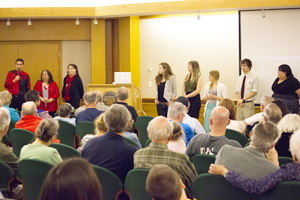 Filmmakers (right) and tribal officials answer questions at the premiere at Ball State University. Filmmakers (right) and tribal officials answer questions at the premiere at Ball State University. |
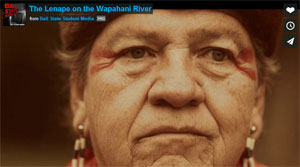
 D5 Creation
D5 Creation